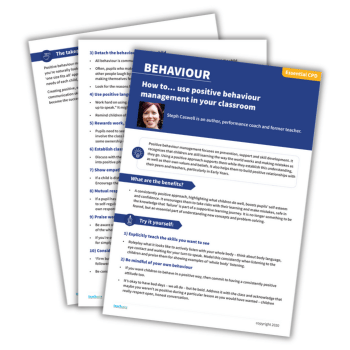Making a difference in schools – a five-part framework for success

‘Having an impact’ might seem like a nebulous concept, but by following these five steps, you can really make a difference to your pupils

- by Nick Hart

In our schools, we should not be putting children first.
Wait, bear with me.
It might be hard to agree with this because it’s considered such a noble sentiment to say that children come first.
But the sentiment is misunderstood. If we were to actually follow this mandate, there could be no end to the demands placed on us, all in the name of what is best for the children.
We should keep in mind that, ultimately, we’re aiming to make a difference to pupils’ lives. And that doesn’t just mean academically, but socially, emotionally, behaviourally and more.
If we’re going to achieve these outcomes, though, it will be because we have a team of motivated, happy staff, unburdened by excessive workload and free to develop their practice in an environment characterised by psychological safety and trust, by clarity of purpose and collective efficacy.
Our colleagues come first so that they can do brilliant work with children.
Cause and effect
Schools are complex. Each day there are innumerable interactions between colleagues and children; a tangle of multiple causes and effects, each influencing the others.
It is this complexity that makes teaching and school improvement at once both exciting and frustrating.
We have to understand that every action will advantage some staff and children, while disadvantaging others. Our best-laid plans will never lead to blanket improvement – our classes and our schools sometimes lean into our improvement efforts and at other times evade them.
Sometimes we make things better and sometimes we inadvertently make them worse.
Now, depending on your mindset, you might find this reassuring. It might satisfy the niggle that makes you wonder why your carefully thought-out plans didn’t work out as expected.
Or you might find it stressful, especially when it becomes clear that we have far less control than we might like to believe.
To make a difference we have to appreciate complexity, and this requires us to pay attention differently.
The five-part framework for making a difference in schools is a way of doing just that.
A framework for improvement
We undoubtedly have grand aims for children to flourish in different ways in their time with us, but we don’t necessarily have direct influence on how they respond to our efforts as leaders.
It is the teachers and TAs working with children in classrooms that have a greater degree of influence on the development of the children in their care.
So, to make a difference to children’s outcomes we must seek to influence these direct connects – we’ll call them ‘impact domains’.
The first domain is climate. This refers to how it feels for colleagues to work in our schools; their lived experience. It includes the extent to which staff feel psychologically safe, the trust they have in their colleagues, the autonomy they have over their working practices, how successful they feel in their job, and more.
The second domain is systems and processes. Leaders create systems for all aspects of school life including the curriculum, behaviour, safeguarding, how teachers plan lessons, and CPD, etc.
The third domain is colleagues’ behaviours. What adults do every day in terms of how they manage behaviour, how they explain concepts or how they engage with CPD is what makes a difference to children’s learning.
The fourth domain is colleagues’ knowledge. What our colleagues know about teaching and behaviour, as well as the informal knowledge of the children that they teach and the fellow staff they work with, shapes their actions.
The fifth and final domain is outcomes for children. These outcomes include the academic and the pastoral.
So, how does this help? Well, if we are tasked with improving something at school, for example phonics attainment in Year 1, the framework can help us to understand the problem more fully and fight the urge to claim a single cause for the poor attainment.
Trending
We can consider:
- The phonics climate
How do colleagues feel about teaching phonics? Do they have enough autonomy over their practice? Do they feel successful in teaching phonics? Do they understand the reasons why we chosen the approach that we have?
- The phonics systems
When is phonics timetabled? How do teachers plan? Is the sequence of learning optimal? How do children behave in phonics lessons? How do we approach phonics CPD?
- Individual behaviours
How do teachers model and explain decoding and reading fluency? How do they check that children have understood new sounds? How do they correct errors in decoding?
- What colleagues know
How is their knowledge of the alphabetic code? What do they know about phonics pedagogy? What do they know of each child in their class, including the sounds they do and don’t know, and their proficiency in segmenting and blending?
- The outcomes
Which sounds do children know and not know? What patterns are there in the cohort’s segmenting, blending and reading fluency? To what extent do they feel successful and enjoy phonics lessons?
Digging deeper into these impact domains can help us to get a more accurate and more rounded picture of the problem, so that we can take the most appropriate, coordinated action.
Of course, this doesn’t just work for leaders – if you’re a classroom teacher, you can use the framework to evaluate your pedagogy or individual class.
This might include a combination of building subject knowledge (e.g. of the phonetic code and how the chosen programme works), or refining practice in modelling and checking understanding.
It might include reviewing the teaching sequence of sounds or tightening up routines in phonics lessons. Or it might be seeking ways to increase autonomy in the classroom.
The framework helps us to deliberately and systematically build our knowledge of the reality of school life.
Considering a problem from multiple angles in this way makes it more likely that we select solutions that will make a difference.
How to use the framework
- Check assumptions
A very common trap for leaders to fall into when monitoring or quality assuring, is to use too small a range of activities to understand the reality of school life.
We might make assumptions after a couple of lesson observations or flicking through some children’s books.
If, however, we take the time to gather information from a range of sources, we’re more likely to end up with reliable information upon which we can make more valid inferences.
- A well-rounded plan
Each impact domain influences the others in ways that we might predict, and in some ways that are unforeseeable.
But by addressing each domain, we are more likely to develop a joined-up approach to dealing with problems.
Outcomes at scale won’t happen unless we have systems, so an implementation plan must include the design of school-wide structures.
These can’t be established without changes to individuals’ behaviour, so an implementation plan must also include what we want colleagues to do differently, and how we’ll support them to do so.
Similarly, said behaviour can’t improve without staff knowing more first, so your plan should, in the first instance, consider what colleagues need to know and how you’ll build that knowledge.
Nick Hart is the executive headteacher of the Alwyn and Courthouse Federation and a visiting fellow at Ambition Institute. Follow Nick on Twitter @mrnickhart and see more of his work at mrnickhart.wordpress.com







